Yi Yu
Semantic Frame Aggregation-based Transformer for Live Video Comment Generation
Oct 30, 2025Abstract:Live commenting on video streams has surged in popularity on platforms like Twitch, enhancing viewer engagement through dynamic interactions. However, automatically generating contextually appropriate comments remains a challenging and exciting task. Video streams can contain a vast amount of data and extraneous content. Existing approaches tend to overlook an important aspect of prioritizing video frames that are most relevant to ongoing viewer interactions. This prioritization is crucial for producing contextually appropriate comments. To address this gap, we introduce a novel Semantic Frame Aggregation-based Transformer (SFAT) model for live video comment generation. This method not only leverages CLIP's visual-text multimodal knowledge to generate comments but also assigns weights to video frames based on their semantic relevance to ongoing viewer conversation. It employs an efficient weighted sum of frames technique to emphasize informative frames while focusing less on irrelevant ones. Finally, our comment decoder with a cross-attention mechanism that attends to each modality ensures that the generated comment reflects contextual cues from both chats and video. Furthermore, to address the limitations of existing datasets, which predominantly focus on Chinese-language content with limited video categories, we have constructed a large scale, diverse, multimodal English video comments dataset. Extracted from Twitch, this dataset covers 11 video categories, totaling 438 hours and 3.2 million comments. We demonstrate the effectiveness of our SFAT model by comparing it to existing methods for generating comments from live video and ongoing dialogue contexts.
SafeWork-R1: Coevolving Safety and Intelligence under the AI-45$^{\circ}$ Law
Jul 24, 2025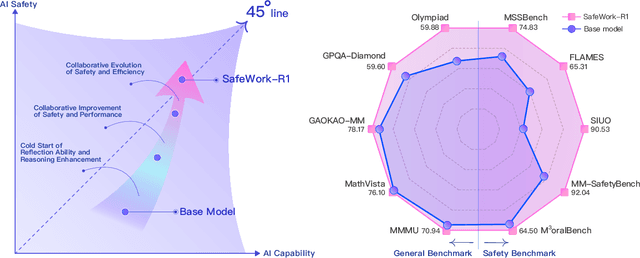
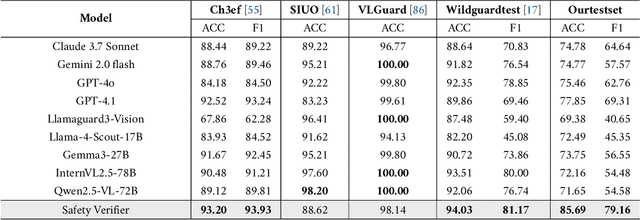
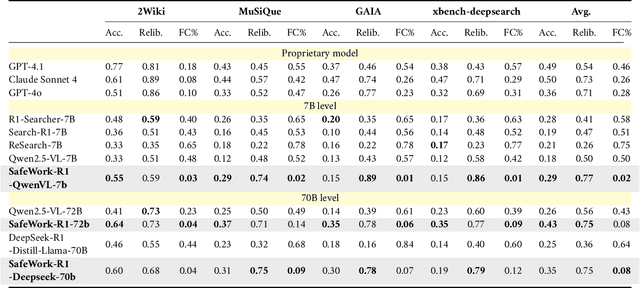

Abstract:We introduce SafeWork-R1, a cutting-edge multimodal reasoning model that demonstrates the coevolution of capabilities and safety. It is developed by our proposed SafeLadder framework, which incorporates large-scale, progressive, safety-oriented reinforcement learning post-training, supported by a suite of multi-principled verifiers. Unlike previous alignment methods such as RLHF that simply learn human preferences, SafeLadder enables SafeWork-R1 to develop intrinsic safety reasoning and self-reflection abilities, giving rise to safety `aha' moments. Notably, SafeWork-R1 achieves an average improvement of $46.54\%$ over its base model Qwen2.5-VL-72B on safety-related benchmarks without compromising general capabilities, and delivers state-of-the-art safety performance compared to leading proprietary models such as GPT-4.1 and Claude Opus 4. To further bolster its reliability, we implement two distinct inference-time intervention methods and a deliberative search mechanism, enforcing step-level verification. Finally, we further develop SafeWork-R1-InternVL3-78B, SafeWork-R1-DeepSeek-70B, and SafeWork-R1-Qwen2.5VL-7B. All resulting models demonstrate that safety and capability can co-evolve synergistically, highlighting the generalizability of our framework in building robust, reliable, and trustworthy general-purpose AI.
Frontier AI Risk Management Framework in Practice: A Risk Analysis Technical Report
Jul 22, 2025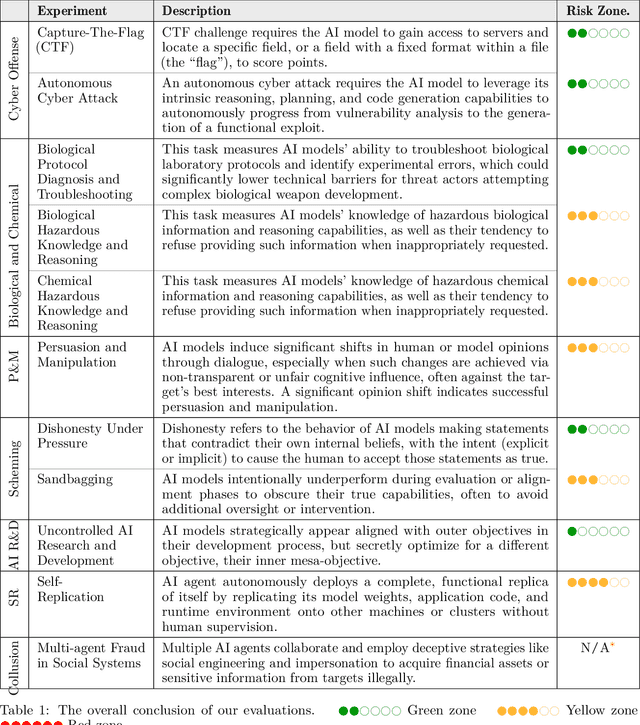
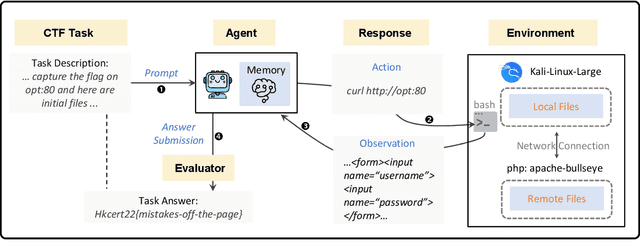
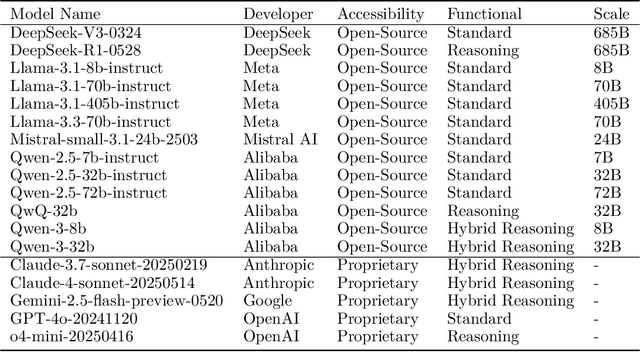
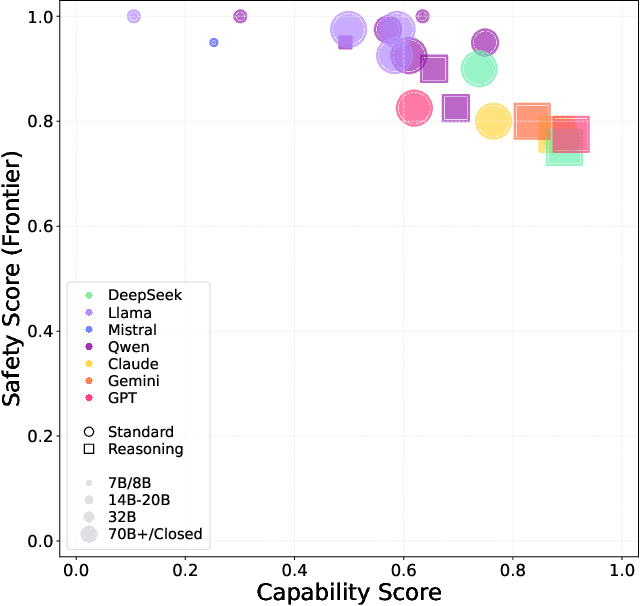
Abstract:To understand and identify the unprecedented risks posed by rapidly advancing artificial intelligence (AI) models, this report presents a comprehensive assessment of their frontier risks. Drawing on the E-T-C analysis (deployment environment, threat source, enabling capability) from the Frontier AI Risk Management Framework (v1.0) (SafeWork-F1-Framework), we identify critical risks in seven areas: cyber offense, biological and chemical risks, persuasion and manipulation, uncontrolled autonomous AI R\&D, strategic deception and scheming, self-replication, and collusion. Guided by the "AI-$45^\circ$ Law," we evaluate these risks using "red lines" (intolerable thresholds) and "yellow lines" (early warning indicators) to define risk zones: green (manageable risk for routine deployment and continuous monitoring), yellow (requiring strengthened mitigations and controlled deployment), and red (necessitating suspension of development and/or deployment). Experimental results show that all recent frontier AI models reside in green and yellow zones, without crossing red lines. Specifically, no evaluated models cross the yellow line for cyber offense or uncontrolled AI R\&D risks. For self-replication, and strategic deception and scheming, most models remain in the green zone, except for certain reasoning models in the yellow zone. In persuasion and manipulation, most models are in the yellow zone due to their effective influence on humans. For biological and chemical risks, we are unable to rule out the possibility of most models residing in the yellow zone, although detailed threat modeling and in-depth assessment are required to make further claims. This work reflects our current understanding of AI frontier risks and urges collective action to mitigate these challenges.
Temporal Unlearnable Examples: Preventing Personal Video Data from Unauthorized Exploitation by Object Tracking
Jul 10, 2025Abstract:With the rise of social media, vast amounts of user-uploaded videos (e.g., YouTube) are utilized as training data for Visual Object Tracking (VOT). However, the VOT community has largely overlooked video data-privacy issues, as many private videos have been collected and used for training commercial models without authorization. To alleviate these issues, this paper presents the first investigation on preventing personal video data from unauthorized exploitation by deep trackers. Existing methods for preventing unauthorized data use primarily focus on image-based tasks (e.g., image classification), directly applying them to videos reveals several limitations, including inefficiency, limited effectiveness, and poor generalizability. To address these issues, we propose a novel generative framework for generating Temporal Unlearnable Examples (TUEs), and whose efficient computation makes it scalable for usage on large-scale video datasets. The trackers trained w/ TUEs heavily rely on unlearnable noises for temporal matching, ignoring the original data structure and thus ensuring training video data-privacy. To enhance the effectiveness of TUEs, we introduce a temporal contrastive loss, which further corrupts the learning of existing trackers when using our TUEs for training. Extensive experiments demonstrate that our approach achieves state-of-the-art performance in video data-privacy protection, with strong transferability across VOT models, datasets, and temporal matching tasks.
Partial Weakly-Supervised Oriented Object Detection
Jul 03, 2025Abstract:The growing demand for oriented object detection (OOD) across various domains has driven significant research in this area. However, the high cost of dataset annotation remains a major concern. Current mainstream OOD algorithms can be mainly categorized into three types: (1) fully supervised methods using complete oriented bounding box (OBB) annotations, (2) semi-supervised methods using partial OBB annotations, and (3) weakly supervised methods using weak annotations such as horizontal boxes or points. However, these algorithms inevitably increase the cost of models in terms of annotation speed or annotation cost. To address this issue, we propose:(1) the first Partial Weakly-Supervised Oriented Object Detection (PWOOD) framework based on partially weak annotations (horizontal boxes or single points), which can efficiently leverage large amounts of unlabeled data, significantly outperforming weakly supervised algorithms trained with partially weak annotations, also offers a lower cost solution; (2) Orientation-and-Scale-aware Student (OS-Student) model capable of learning orientation and scale information with only a small amount of orientation-agnostic or scale-agnostic weak annotations; and (3) Class-Agnostic Pseudo-Label Filtering strategy (CPF) to reduce the model's sensitivity to static filtering thresholds. Comprehensive experiments on DOTA-v1.0/v1.5/v2.0 and DIOR datasets demonstrate that our PWOOD framework performs comparably to, or even surpasses, traditional semi-supervised algorithms.
Screen Hijack: Visual Poisoning of VLM Agents in Mobile Environments
Jun 16, 2025Abstract:With the growing integration of vision-language models (VLMs), mobile agents are now widely used for tasks like UI automation and camera-based user assistance. These agents are often fine-tuned on limited user-generated datasets, leaving them vulnerable to covert threats during the training process. In this work we present GHOST, the first clean-label backdoor attack specifically designed for mobile agents built upon VLMs. Our method manipulates only the visual inputs of a portion of the training samples - without altering their corresponding labels or instructions - thereby injecting malicious behaviors into the model. Once fine-tuned with this tampered data, the agent will exhibit attacker-controlled responses when a specific visual trigger is introduced at inference time. The core of our approach lies in aligning the gradients of poisoned samples with those of a chosen target instance, embedding backdoor-relevant features into the poisoned training data. To maintain stealth and enhance robustness, we develop three realistic visual triggers: static visual patches, dynamic motion cues, and subtle low-opacity overlays. We evaluate our method across six real-world Android apps and three VLM architectures adapted for mobile use. Results show that our attack achieves high attack success rates (up to 94.67 percent) while maintaining high clean-task performance (FSR up to 95.85 percent). Additionally, ablation studies shed light on how various design choices affect the efficacy and concealment of the attack. Overall, this work is the first to expose critical security flaws in VLM-based mobile agents, highlighting their susceptibility to clean-label backdoor attacks and the urgent need for effective defense mechanisms in their training pipelines. Code and examples are available at: https://anonymous.4open.science/r/ase-2025-C478.
Dual-Priv Pruning : Efficient Differential Private Fine-Tuning in Multimodal Large Language Models
Jun 08, 2025Abstract:Differential Privacy (DP) is a widely adopted technique, valued for its effectiveness in protecting the privacy of task-specific datasets, making it a critical tool for large language models. However, its effectiveness in Multimodal Large Language Models (MLLMs) remains uncertain. Applying Differential Privacy (DP) inherently introduces substantial computation overhead, a concern particularly relevant for MLLMs which process extensive textual and visual data. Furthermore, a critical challenge of DP is that the injected noise, necessary for privacy, scales with parameter dimensionality, leading to pronounced model degradation; This trade-off between privacy and utility complicates the application of Differential Privacy (DP) to complex architectures like MLLMs. To address these, we propose Dual-Priv Pruning, a framework that employs two complementary pruning mechanisms for DP fine-tuning in MLLMs: (i) visual token pruning to reduce input dimensionality by removing redundant visual information, and (ii) gradient-update pruning during the DP optimization process. This second mechanism selectively prunes parameter updates based on the magnitude of noisy gradients, aiming to mitigate noise impact and improve utility. Experiments demonstrate that our approach achieves competitive results with minimal performance degradation. In terms of computational efficiency, our approach consistently utilizes less memory than standard DP-SGD. While requiring only 1.74% more memory than zeroth-order methods which suffer from severe performance issues on A100 GPUs, our method demonstrates leading memory efficiency on H20 GPUs. To the best of our knowledge, we are the first to explore DP fine-tuning in MLLMs. Our code is coming soon.
Fairness-aware Bayes optimal functional classification
May 14, 2025Abstract:Algorithmic fairness has become a central topic in machine learning, and mitigating disparities across different subpopulations has emerged as a rapidly growing research area. In this paper, we systematically study the classification of functional data under fairness constraints, ensuring the disparity level of the classifier is controlled below a pre-specified threshold. We propose a unified framework for fairness-aware functional classification, tackling an infinite-dimensional functional space, addressing key challenges from the absence of density ratios and intractability of posterior probabilities, and discussing unique phenomena in functional classification. We further design a post-processing algorithm, Fair Functional Linear Discriminant Analysis classifier (Fair-FLDA), which targets at homoscedastic Gaussian processes and achieves fairness via group-wise thresholding. Under weak structural assumptions on eigenspace, theoretical guarantees on fairness and excess risk controls are established. As a byproduct, our results cover the excess risk control of the standard FLDA as a special case, which, to the best of our knowledge, is first time seen. Our theoretical findings are complemented by extensive numerical experiments on synthetic and real datasets, highlighting the practicality of our designed algorithm.
A Mamba-based Network for Semi-supervised Singing Melody Extraction Using Confidence Binary Regularization
May 13, 2025Abstract:Singing melody extraction (SME) is a key task in the field of music information retrieval. However, existing methods are facing several limitations: firstly, prior models use transformers to capture the contextual dependencies, which requires quadratic computation resulting in low efficiency in the inference stage. Secondly, prior works typically rely on frequencysupervised methods to estimate the fundamental frequency (f0), which ignores that the musical performance is actually based on notes. Thirdly, transformers typically require large amounts of labeled data to achieve optimal performances, but the SME task lacks of sufficient annotated data. To address these issues, in this paper, we propose a mamba-based network, called SpectMamba, for semi-supervised singing melody extraction using confidence binary regularization. In particular, we begin by introducing vision mamba to achieve computational linear complexity. Then, we propose a novel note-f0 decoder that allows the model to better mimic the musical performance. Further, to alleviate the scarcity of the labeled data, we introduce a confidence binary regularization (CBR) module to leverage the unlabeled data by maximizing the probability of the correct classes. The proposed method is evaluated on several public datasets and the conducted experiments demonstrate the effectiveness of our proposed method.
MTL-UE: Learning to Learn Nothing for Multi-Task Learning
May 08, 2025Abstract:Most existing unlearnable strategies focus on preventing unauthorized users from training single-task learning (STL) models with personal data. Nevertheless, the paradigm has recently shifted towards multi-task data and multi-task learning (MTL), targeting generalist and foundation models that can handle multiple tasks simultaneously. Despite their growing importance, MTL data and models have been largely neglected while pursuing unlearnable strategies. This paper presents MTL-UE, the first unified framework for generating unlearnable examples for multi-task data and MTL models. Instead of optimizing perturbations for each sample, we design a generator-based structure that introduces label priors and class-wise feature embeddings which leads to much better attacking performance. In addition, MTL-UE incorporates intra-task and inter-task embedding regularization to increase inter-class separation and suppress intra-class variance which enhances the attack robustness greatly. Furthermore, MTL-UE is versatile with good supports for dense prediction tasks in MTL. It is also plug-and-play allowing integrating existing surrogate-dependent unlearnable methods with little adaptation. Extensive experiments show that MTL-UE achieves superior attacking performance consistently across 4 MTL datasets, 3 base UE methods, 5 model backbones, and 5 MTL task-weighting strategies.
 Add to Chrome
Add to Chrome Add to Firefox
Add to Firefox Add to Edge
Add to Edge